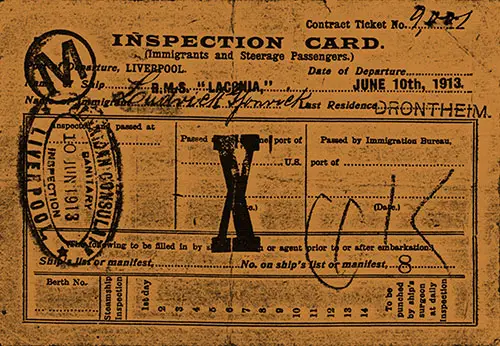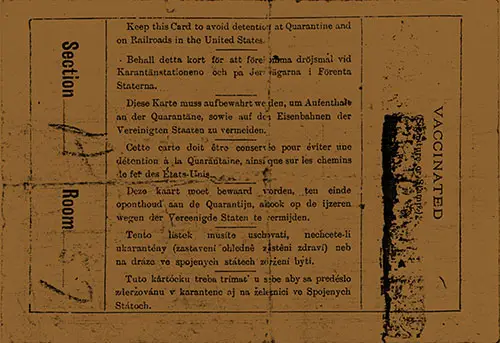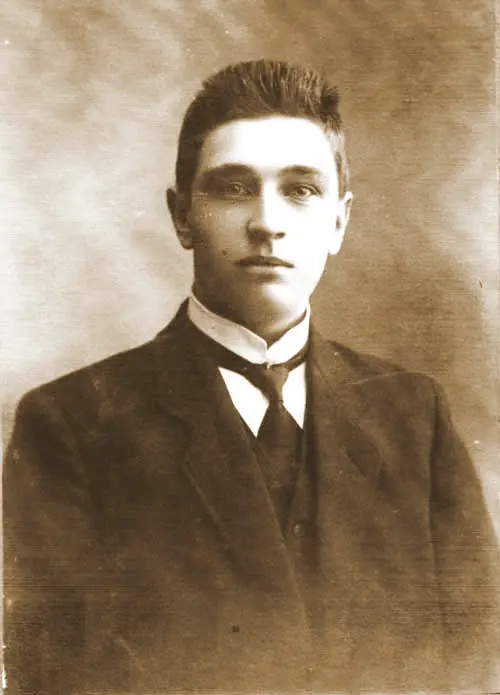🛳 RMS Laconia Immigrant Inspection Card (1913) – Norwegian Migration & Early 20th-Century Ocean Travel
📌 Explore the 1913 Immigrant Inspection Card from the RMS Laconia, issued to Norwegian immigrant Ludvig Gjønvik. This historical artifact reveals the rigorous immigration and medical inspection process aboard Cunard’s transatlantic liners. Perfect for historians, genealogists, educators, and maritime enthusiasts interested in early 20th-century immigration.
🛳 RMS Laconia Inspection Card (1913) – A Glimpse into the Immigrant Experience
A Rare Piece of Immigration History
This 1913 Immigrant Inspection Card from the Cunard Line's RMS Laconia is a fascinating primary source document that provides a first-hand look into the transatlantic immigration process of the early 20th century. Issued to Norwegian immigrant Ludvig Gjønvik, this card was an essential part of the immigration journey, ensuring compliance with medical, sanitary, and quarantine regulations upon arrival in the United States.
For teachers, students, genealogists, and historians, this page serves as an invaluable resource for understanding:
✔ The bureaucratic processes that immigrants faced
✔ Medical and quarantine requirements in early 20th-century immigration
✔ The importance of ocean liners in the mass migration from Europe to America
✔ The Cunard Line’s role in facilitating transatlantic immigration
🔹 This document is more than just a piece of paper—it represents the hopes, struggles, and resilience of immigrants seeking a better future in America.

Front Side of an Immigrant Inspection Card, Issued in 1913 by the Cunard Line on Board the RMS Laconia to a Norwegian Immigrant Traveling in Steerage. | GGA Image ID # 1e9d9dcfc0
The card provided important information, including port and date of departure, name of ship, immigrant name, last residence, medical inspection stamps, and evidence of immunization.
Sanitary Inspection 10 June 1913
for Ludvig Gjønvik
Section A, Room 57 aboard the RMS Laconia
Front Side of Immigrant and Steerage Passengers' Inspection Card - 1913
- Port of Departure: Liverpool
- Date of Departure: 10 June 1913
- Name of Ship: RMS Laconia
- Name of Immigrant: Ludvick Gjønvik
- Last Residence: Drontheim (Trondheim, Norway)
- Contract Ticket Number: 9227?
- Inspected and Passed at ???den Consulate, Liverpool Sanitary Inspection 10 June 1913
- No. on Ships List or manifest: 8
- Stamped: M and X

Reverse Side of Immigrants and Steerage Passengers Inspection Card - 1913. Section A, Room 57. Keep this Card to avoid detention at Quarantine and on Railroads in the United States. The Message is Repeated in Swedish, German, French, Dutch, Polish, and Slavic. Vaccinated indicated by Stamp. | GGA Image ID # 1e9dcce8ea

Norwegian Immigrant, Ludvig Gjønvik circa 1913. | GGA Image ID # 1e9de4e52d
Learn more about Ludvig Gjønvik, a Norwegian immigrant to America in 1913:
🇳🇴 From Norway to America: The Inspiring Journey of Immigrant Ludvig Kristian Gjønvik
📌 Explore the remarkable immigration story of Ludvig Kristian Gjønvik, a Norwegian immigrant who overcame orphanhood, financial struggles, and war to build a new life in America. Perfect for historians, genealogists, educators, and students exploring early 20th-century immigration.
🛳 The RMS Franconia & Laconia (1912) – Cunard’s Luxurious Ocean Liners & Their Tragic Fate
📌 Explore the 1912 Cunard Line brochure detailing the RMS Franconia and RMS Laconia, two of the most luxurious yet short-lived transatlantic liners. This historical gem highlights lavish first-class accommodations, improved second and third-class facilities, and advanced maritime technology—before both ships were sunk in World War I. Ideal for historians, genealogists, students, and maritime enthusiasts.
🗂️ What Makes This Inspection Card Significant?
🔎 A Closer Look at the Document
✔ Issued by: The Cunard Line aboard the RMS Laconia
✔ Date of Departure: 10 June 1913 from Liverpool
✔ Immigrant Name: Ludvig Gjønvik
✔ Last Residence: Trondheim, Norway
✔ Ship’s Manifest Information: Section A, Room 57, Manifest No. 8
✔ Sanitary Inspection Approval: Stamped in Liverpool on 10 June 1913
✔ Medical & Vaccination Confirmation: Marked by official stamps
✔ Instructions to Immigrants: “Keep this card to avoid detention at quarantine and on railroads in the United States.” (Translated into Swedish, German, French, Dutch, Polish, and Slavic)
🔹 This card served as a passport of sorts for newly arrived immigrants, ensuring they had met the required health and entry regulations before being allowed to travel further into the U.S.
🚢 The Journey of Norwegian Immigrant Ludvig Gjønvik
This document is directly linked to Ludvig Kristian Gjønvik, a Norwegian immigrant who set out on a life-changing journey to America in 1913.
🌍 His Story in Brief
✔ Born in Trondheim, Norway, in 1892
✔ Lost both parents at age nine, raised by elderly relatives
✔ Became a shoemaker but struggled financially
✔ Took out a loan from relatives to fund his passage to America
✔ Boarded the RMS Laconia as a steerage passenger in June 1913
✔ Arrived in Boston, Massachusetts, and traveled to the Midwest for work
✔ Later served as a U.S. Army Corporal in World War I
✔ Settled in Minneapolis, raised a family, and lived a deeply committed life of faith and service
🔹 His journey represents the millions of immigrants who came to America in search of opportunity and freedom.
🛳 RMS Laconia & Its Role in Immigration
⚓ Ship Background
✔ Built: 1911 by Swan, Hunter & Wigham Richardson Ltd
✔ Owned By: Cunard Line
✔ Service Route: Liverpool to Boston & New York (Primary route for Norwegian, British, and other European immigrants)
✔ Capacity: Carried thousands of immigrants in steerage every year
✔ Sunk in WWI: Torpedoed by German U-50 on 25 February 1917
🔹 The RMS Laconia played a vital role in transatlantic migration, transporting thousands of European immigrants to North America before its tragic wartime loss.
📸 Noteworthy Images from This Page
📷 1913 Immigrant Inspection Card – Front Side
A detailed look at the official inspection card issued to steerage passengers on the RMS Laconia, including medical stamps and personal details of the immigrant.
📷 1913 Immigrant Inspection Card – Reverse Side
Provides insight into the multilingual instructions given to immigrants, ensuring they retained this vital document to avoid delays or deportation.
📷 Norwegian Immigrant Ludvig Gjønvik (Circa 1913)
A rare photograph of an immigrant who traveled aboard the RMS Laconia, giving a human face to the historical document.
📌 Final Thoughts: Why This Document Matters
This 1913 RMS Laconia Immigrant Inspection Card is a priceless artifact that offers first-hand insight into early 20th-century immigration policies and the transatlantic migration experience.
🔹 For Historians & Educators – This document illustrates the rigorous screening process that immigrants underwent and the bureaucracy of mass migration.
🔹 For Genealogists – Family historians researching Norwegian or European ancestry will find immigrant inspection cards crucial in tracing ancestors' journeys.
🔹 For Students – This real-life immigration document makes history more engaging and relatable, connecting the past to the present-day immigration experience.
🔹 For Maritime Enthusiasts – The RMS Laconia was one of Cunard’s major immigrant carriers before being sunk in World War I, marking its place in maritime history.
This piece of history serves as a reminder of the struggles, determination, and resilience of those who sought a better life across the Atlantic.
